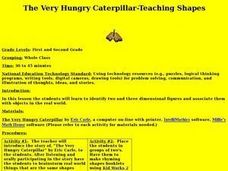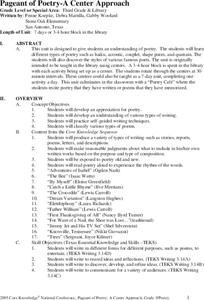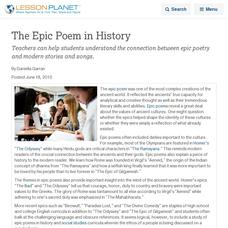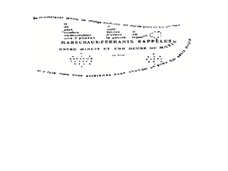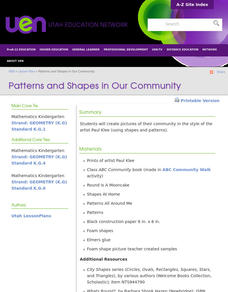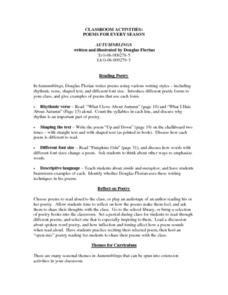Curated OER
Discussing Poetry In Class
Learners investigate syllabic metre and rhyming techniques by analyzing poetry. In this language arts lesson, students read the poem Considering the Snail and discuss the nature and mood of the poem with their classmates....
Southern Nevada Regional Professional Development Program
Poetry Aloud/Poetry Out Loud
To appreciate the value of seeing and hearing a poetry performance, groups prepare readings of selected poems and then compare and critique their interpretations and videotaped versions of the same poem. Included in the resource are...
Curated OER
Poetry Passport
Passport photos are notoriously unflattering but here's an activity that encourages youngsters to create a poetic picture of themselves using each category on the passport as a prompt for a poem.
K12 Reader
Geometric Shape Names
Combine math and language arts in the same lesson with a reading passage about number prefixes in geometric shapes. After reading several short paragraphs about the different prefixes used in shape names, kids answer five comprehension...
Curated OER
The Very Hungry Caterpillar - Teaching Shapes
Young scholars identify two- and three-dimensional figures and associate them with real-world objects. In this geometry instructional activity, students are read The Very Hungry Caterpillar by Eric Carle and complete several...
K12 Reader
Make the Same Shape
Make sure your class has a grasp of words that include the long /a/ sound and follow the _a_e pattern. They can read the short poem on this page, which includes many examples of this pattern to practice, and then complete the three...
Curated OER
Christmas Tree Shaped Poems
Students think about ways in which they can spread joy during the holiday season. They create poems in the shape of a Christmas tree. Pupils use formatting tools in Microsoft Word to format the text of the poem. Students discuss ways...
Curated OER
A Center Approach to Poetry
Students experience the different types of poetry in order to classify them. In this poetry lesson, students discover the multiple types of poetry while reading in the library. Ultimately, the students create their own poetry and share...
Curated OER
Poetic Form
Students read Red Boots On and explore prepositions. In this poetic form lesson plan, students analyze the use of prepositions in the poem. Students might also explore the rhymes or objects. Students write original...
Curated OER
Shapes
Students identify attributes of different geometric shapes. In this geometry lesson, students view a PowerPoint presentation on shapes and use attribute blocks to examine the corners and edges of each shape. Students work together...
Curated OER
The Epic Poem in History
Teachers can help students understand the connection between epic poetry and modern stories and songs.
Curated OER
Picture Perfect Poetry
Do your language arts students love to draw? Use this lesson plan to reinforce poetic techniques with illustration. After drawing what they think poem would look like with no words, middle and high schoolers work on several different...
Utah Education Network (UEN)
Patterns and Shapes In Our Community
Shapes in art, shapes in stories, shapes in the environment, shapes all around. A multi-part lesson that includes looking at the artist Paul Klee's work, reading books about shapes, taking a walk in the neighborhood and identifying...
Project Oceanography
Fish Shape
A fish's size, fins, and shape can tell us a lot about them! Learners explore fish anatomy to see how species use camouflage, scales, shape, and coloration to survive. The lesson includes advanced vocabulary such as fusiform shape,...
Facing History and Ourselves
What Shapes Your Identity?
Sixth graders explore their individual identities. In this personal identity lesson, 6th graders write biopoems using the provided template. Students share their poems and respond to the poetry shared.
National Endowment for the Humanities
Seeing Sense in Photographs & Poems
Learners analyze photographs and poetry as forms of each other. In this poetry and photography analysis lesson, high schoolers use the photographs of Alfred Stieglitz and poetry from William Carlos William to explore how poetry and...
Curated OER
Geometry Poetry
Students write an original diamante poem about a shape of their choice. They examine how to write a diamante poem, and select a shape and write a poem using Microsoft Word software.
Curated OER
Tricks of the Trade A Collection of Concrete Poems-for writing concrete poems
Students explore concrete poetry. In this lesson about poetry, students read A Poke in the I, by Paul B. Janeczko, and are introduced to concrete poems. Students read several different kinds of concrete poems including single-word, and...
Curated OER
Poems for Every Season
Young scholars read and explore autumn poetry. In this poetry instructional activity, students read Autumnblings and are introduced to different poetic forms. Lesson includes ideas for exploring the poetic forms presented in the book and...
Curated OER
Splish, Splash Poetry
Students write weather shape poems and sing weather related songs. In this creative writing lesson, students read the book, It's Raining, It's Pouring and list weather words they heard in the story. Students use the writing process to...
Curated OER
Shape Monster
In this shapes activity, students read a rhyming poem about shapes. Shapes include triangle, circle, oval, square, and rectangle.
Poetry4kids
How to Write a Cinquain Poem
A lesson challenges scholars to create a cinquain poem. Writers begin by choosing a topic and brainstorm details, then compose their original poem making sure to count syllables.
Facing History and Ourselves
Identity and Place
Build scholars' ability to understand their own values and learn about World War II at the same time. Scholars write poetry and discuss identity and place in depth with an in-depth social studies resource.
Great Books Foundation
The Road Not Taken
Every time you make a choice, it prevents another option from taking shape. Spend some time analyzing "The Road Not Taken" by Robert Frost with a reading activity that includes four discussion questions that recall evidence from the text.






